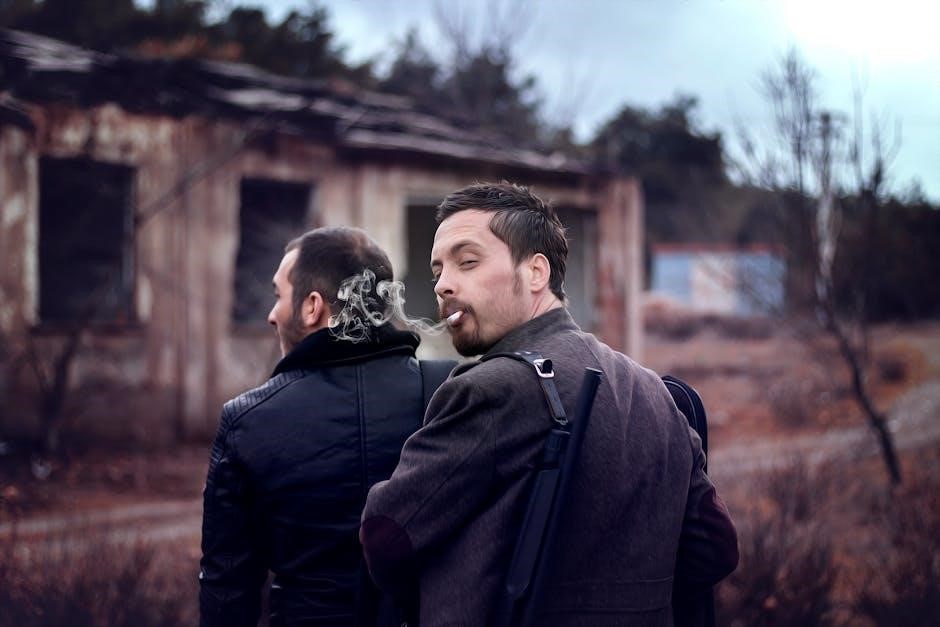Dostoevsky’s final novel‚ The Brothers Karamazov‚ published in 1880‚ explores themes of faith‚ morality‚ and family through the Karamazov brothers and their father in 19th-century Russia.
1.1 Overview of the Novel
The Brothers Karamazov‚ Dostoevsky’s final novel‚ is a profound exploration of faith‚ morality‚ and family dynamics in 19th-century Russia. The story centers on the Karamazov family‚ including the father‚ Fyodor‚ and his four sons‚ each grappling with personal and philosophical struggles. The novel unfolds through a murder mystery‚ a dramatic trial‚ and the brothers’ quest for redemption. It delves into themes of free will‚ doubt‚ and spiritual renewal‚ culminating in one of literature’s most iconic chapters‚ “The Grand Inquisitor.”
1.2 Historical Context
The Brothers Karamazov is set in 19th-century Russia‚ a time of social and philosophical upheaval. Dostoevsky wrote the novel during a period of rapid modernization and intellectual shifts‚ influenced by nihilism and rationalism. The story reflects the tensions between traditional Russian Orthodoxy and emerging secular ideologies. Dostoevsky’s own experiences‚ including his exile and spiritual renewal‚ deeply shaped the novel’s exploration of faith‚ morality‚ and redemption‚ making it a product of its era while remaining universally relevant.

Plot Summary
Murder‚ betrayal‚ and redemption unfold in 19th-century Russia as the Karamazov family navigates a father’s death‚ a brother’s accusation‚ and their own moral and philosophical struggles.
2.1 The Karamazov Family Background
The Karamazov family‚ led by the morally corrupt Fyodor Pavlovich‚ consists of his three sons: Dmitri‚ Ivan‚ and Alyosha. Dmitri‚ the eldest‚ is impulsive and passionate‚ while Ivan‚ the middle brother‚ is intellectual and skeptical. Alyosha‚ the youngest‚ is compassionate and spiritual‚ living in a monastery. Their dysfunctional family dynamics‚ shaped by their father’s greed and infidelity‚ set the stage for the novel’s exploration of moral and philosophical conflicts.
2.2 The Murder Mystery
The novel centers on the murder of Fyodor Pavlovich Karamazov‚ a morally corrupt patriarch‚ whose death sparks a complex investigation. Dmitri‚ the eldest son‚ is accused of the crime due to his turbulent relationship with his father and a disputed inheritance. However‚ the true perpetrator is revealed to be Smerdyakov‚ the family’s illegitimate son and servant‚ who acts out of resentment and manipulation. The mystery unfolds‚ exploring themes of guilt‚ justice‚ and moral accountability.
2.3 The Trial of Dmitri Karamazov
Dmitri Karamazov’s trial is a dramatic climax‚ showcasing the societal and moral tensions of 19th-century Russia. Despite overwhelming circumstantial evidence against him‚ Dmitri maintains his innocence‚ claiming his father’s murderer is Smerdyakov. The trial highlights the clash between rationality and faith‚ as Ivan’s nihilistic views contrast with Alyosha’s unwavering belief in Dmitri’s redemption. The courtroom drama becomes a philosophical debate on guilt‚ justice‚ and the nature of humanity‚ leaving the audience questioning truth and morality.

Main Characters
The Karamazov brothers—Dmitri‚ Ivan‚ Alyosha—and their father Fyodor are central to the novel. Key female characters like Katerina and Grushenka add depth. Servants and monks also play crucial roles.
3.1 The Karamazov Brothers
The three Karamazov brothers—Dmitri‚ Ivan‚ and Alyosha—are central to the novel. Dmitri‚ the eldest‚ is impulsive and passionate‚ often clashing with their father. Ivan‚ the middle brother‚ is intellectual and skeptical‚ grappling with faith and morality. Alyosha‚ the youngest‚ is compassionate and spiritual‚ serving as a moral anchor. Their distinct personalities and conflicts drive the plot‚ exploring themes of free will‚ doubt‚ and redemption.
3.2 Fyodor Pavlovich Karamazov (The Father)
Fyodor Pavlovich Karamazov is the dysfunctional patriarch of the Karamazov family. Known for his greed‚ debauchery‚ and manipulation‚ he embodies moral corruption. His disregard for family and ethics sparks tension among his sons‚ each reacting differently to his influence. His death sets off the central conflict‚ a murder mystery that exposes the darker aspects of his character and the legacy he leaves behind for his sons to navigate.
3.3 Key Female Characters
The female characters in The Brothers Karamazov play pivotal roles in shaping the narrative. Katerina Ivanovna‚ Dmitri’s fiancée‚ represents virtue and resilience‚ while Grushenka‚ a young woman embroiled in a tumultuous relationship with Fyodor‚ symbolizes passion and redemption. Their interactions with the Karamazov men highlight themes of love‚ guilt‚ and moral struggle‚ influencing the brothers’ journeys toward redemption and self-discovery. These women embody both strength and vulnerability‚ adding depth to the novel’s exploration of human nature and societal norms.
3.4 Smerdyakov and Other Servants
Smerdyakov‚ the illegitimate son of Fyodor Karamazov and a mute woman‚ is a pivotal character whose actions drive the plot. His quiet resentment and intellectual curiosity mask a darker nature‚ ultimately leading to tragic consequences. Other servants‚ like Marfa and Grigory‚ provide moral stability and loyalty amidst the family’s chaos. Their roles highlight the social hierarchy and moral contrasts within the Karamazov household‚ offering insights into the novel’s exploration of class‚ morality‚ and human frailty.
3.5 Father Zossima and the Monastery
Father Zossima‚ a revered monk and spiritual leader‚ embodies wisdom and compassion. His life story reveals a journey from sin to redemption‚ influencing Alyosha deeply. The monastery serves as a refuge for Alyosha‚ contrasting the moral decay of the Karamazov family. Through Zossima’s teachings and the monastery’s serene atmosphere‚ the novel explores themes of faith‚ forgiveness‚ and spiritual renewal‚ offering a counterpoint to the chaos and corruption in the secular world.

Themes and Philosophical Ideas
The novel explores profound themes of faith‚ doubt‚ morality‚ free will‚ and redemption‚ delving into existential questions about God‚ humanity‚ and the meaning of life.
4.1 Faith and Doubt
The Brothers Karamazov profoundly explores the struggle between faith and doubt through the Karamazov brothers. Ivan’s intellectual atheism clashes with Alyosha’s devout belief‚ while Dmitri’s spiritual turmoil deepens the complexity. The iconic chapter “The Grand Inquisitor” questions divine authority and human free will‚ reflecting Dostoevsky’s own grappling with religion. The novel suggests that faith is not about certainty but about embracing the mystery‚ even in the face of suffering and existential despair. This theme remains central to the novel’s philosophical and emotional core.
4.2 Morality and Moral Responsibility
The Brothers Karamazov delves deeply into moral dilemmas‚ exploring the consequences of choices and the nature of right and wrong. The novel highlights the moral decay of Fyodor Pavlovich‚ contrasting it with the ethical struggles of his sons. Ivan’s moral skepticism and Dmitri’s passion-driven actions underscore the complexity of moral responsibility. Through Alyosha’s compassion and wisdom‚ Dostoevsky suggests that true morality lies in self-reflection‚ empathy‚ and the pursuit of spiritual truth‚ emphasizing the individual’s role in shaping their moral destiny.
4.3 Free Will vs. Determinism
The Brothers Karamazov explores the tension between free will and determinism‚ particularly through Ivan’s philosophical arguments. Ivan’s belief in moral determinism clashes with Alyosha’s faith in human freedom and moral choice. The novel questions whether individuals are bound by external forces or capable of self-determined acts. Dostoevsky examines this through the brothers’ divergent paths‚ highlighting the existential struggle between predetermined fate and personal agency‚ ultimately emphasizing the complexity of human choice and its moral implications.
4.4 Redemption and Forgiveness
Redemption and forgiveness are central themes‚ particularly through Alyosha’s unwavering compassion. His belief in the possibility of redemption‚ even for the most flawed individuals‚ contrasts with Ivan’s cynicism and Dmitri’s guilt. Through Alyosha’s guidance‚ characters confront their sins‚ seeking forgiveness and personal transformation. The novel underscores the power of love and humility in achieving redemption‚ offering hope and spiritual renewal amidst moral and emotional turmoil‚ reflecting Dostoevsky’s belief in the human capacity for grace and reconciliation.

Symbolism in the Novel
Dostoevsky employs rich symbolism‚ such as the monastery representing spiritual refuge and the color red symbolizing passion and death‚ enhancing the novel’s philosophical depth.

5.1 The Grand Inquisitor
The Grand Inquisitor‚ from Ivan’s poem‚ symbolizes oppressive authority and the suppression of free will. He represents the Church’s control over humanity‚ rejecting Christ’s offer of freedom‚ highlighting themes of faith‚ power‚ and moral responsibility. This chapter is a philosophical cornerstone‚ exploring the tension between divine authority and human autonomy‚ reflecting Dostoevsky’s profound examination of spirituality and societal structures in 19th-century Russia.
5.2 The Monastery as a Symbol ofSpirituality
5.2 The Monastery as a Symbol of Spirituality
The monastery in The Brothers Karamazov serves as a sacred space representing spirituality and moral guidance. It embodies the ideals of faith‚ humility‚ and redemption‚ contrasting with the corruption of the secular world. Father Zossima’s presence further sanctifies it‚ offering a refuge for characters seeking enlightenment. The monastery symbolizes the enduring power of faith and the possibility of spiritual renewal amidst chaos‚ central to Dostoevsky’s exploration of religious and philosophical themes in 19th-century Russia.
5.3 The Color Red and Its Significance
The color red in The Brothers Karamazov symbolizes passion‚ bloodshed‚ and pivotal events. It is often associated with the novel’s themes of violence‚ guilt‚ and moral reckoning. Red appears in the murder scene of Fyodor Pavlovich‚ emphasizing the brutality and consequences of the act. Additionally‚ red is linked to Dmitri’s fiery temperament and his emotional struggles‚ reflecting the intense inner turmoil of the characters. Dostoevsky uses red to underscore the novel’s dramatic and symbolic depth‚ tying it to themes of redemption and moral conflict.

The Title and Its Significance
The title reflects the novel’s focus on the Karamazov brothers‚ emphasizing their collective role in exploring themes of faith‚ morality‚ and redemption‚ culminating in the epilogue’s resolution.
6.1 The Meaning of “The Brothers Karamazov”
The title emphasizes the collective journey of the Karamazov brothers‚ highlighting their interconnected lives and struggles. It underscores the novel’s exploration of brotherhood‚ moral dilemmas‚ and redemption. The title reflects the shared experiences and conflicts that define their lives‚ while also symbolizing the broader themes of faith‚ doubt‚ and human nature. The brothers’ diverse paths illustrate the complexity of existence‚ making the title a fitting encapsulation of the novel’s philosophical depth and familial drama. The title’s simplicity belies the profound exploration of human condition within.
6.2 The Role of the Epilogue
The epilogue serves as a resolution‚ offering hope and closure after the turmoil. It focuses on Alyosha’s speech at the stone‚ where he emphasizes love‚ forgiveness‚ and the promise of eternal life. The epilogue ties together the novel’s themes of redemption and faith‚ providing a sense of renewal. It also highlights the enduring impact of Father Zossima’s teachings and the possibility of healing and unity among the characters. The epilogue leaves readers with a sense of optimism and spiritual renewal.

Style and Literary Devices
Dostoevsky’s writing style in The Brothers Karamazov is known for its psychological depth‚ philosophical themes‚ and intense dialogue. His use of monologue reveals character complexity and moral struggles effectively.
7.1 Dostoevsky’s Writing Style
Dostoevsky’s writing style in The Brothers Karamazov is characterized by its psychological depth‚ philosophical themes‚ and intense dialogue. His prose is dense and layered‚ exploring the human psyche with remarkable insight. Dostoevsky’s use of realistic descriptions and dramatic tension creates a vivid portrayal of 19th-century Russia. His writing often delves into the inner struggles of characters‚ revealing their moral and spiritual conflicts. The novel’s complex narrative structure and philosophical debates showcase Dostoevsky’s mastery of blending storytelling with profound intellectual inquiry‚ making his style both distinctive and influential in world literature.
7.2 Use of Dialogue and Monologue

Dostoevsky employs dialogue and monologue extensively in The Brothers Karamazov to reveal character depth and convey philosophical ideas. Conversations between the Karamazov brothers are charged with emotional intensity‚ often exposing their conflicting beliefs. Monologues‚ particularly Ivan’s “Rebellion” and the “Grand Inquisitor” parable‚ serve as vehicles for exploring moral and existential dilemmas. These dialogues and monologues not only advance the plot but also encapsulate the novel’s central themes‚ making them a powerful tool for psychological and philosophical exploration. Dostoevsky’s use of direct speech creates a vivid‚ immersive narrative experience.
7.3 Psychological Depth in Characters
Dostoevsky masterfully crafts the Karamazov brothers and their father with profound psychological complexity. Each character embodies distinct traits: Ivan’s intellectual skepticism‚ Dmitri’s passionate turmoil‚ Alyosha’s compassionate faith‚ and Fyodor’s selfish debauchery. Through their dialogues‚ monologues‚ and internal struggles‚ Dostoevsky probes their psyches‚ revealing their moral and existential conflicts. The novel’s exploration of their mental and emotional states creates a rich tapestry of human nature‚ making them universally relatable. This depth underscores the novel’s enduring relevance in exploring the human condition.

Reception and Legacy
The Brothers Karamazov was widely acclaimed in 19th-century Russia for its psychological depth and philosophical themes. Its influence on world literature is immense‚ shaping modern storytelling and psychological insights.
8.1 Initial Reception in 19th-Century Russia
The Brothers Karamazov received widespread acclaim upon its 1880 release in Russia. Critics praised its profound exploration of faith‚ morality‚ and family dynamics. The novel’s bold narrative style and complex characters resonated deeply with readers‚ establishing it as a landmark of Russian literature. Its themes of existential doubt and redemption sparked intense debates‚ further cementing its reputation as a masterpiece of psychological and philosophical fiction.
8.2 Modern Interpretations and Adaptations
The Brothers Karamazov continues to inspire modern adaptations‚ including films‚ stage productions‚ and TV series. Its universal themes of faith‚ morality‚ and redemption remain relevant today. The novel has been translated into numerous languages‚ with recent translations like Michael R. Katz’s 2024 version introducing it to new readers. Theater adaptations‚ such as the acclaimed Circle X production‚ highlight its dramatic potential. Modern interpretations often emphasize its psychological depth and philosophical questions‚ ensuring its enduring influence on global literature and art.
8.3 The Novel’s Impact on World Literature
The Brothers Karamazov has profoundly influenced world literature‚ shaping existentialist and psychological fiction. Its exploration of human nature‚ faith‚ and morality inspired writers like Albert Camus and Jean-Paul Sartre. The novel’s complex characters and philosophical debates set a new standard for literary depth. Translated into many languages‚ it remains a cornerstone of Russian literature‚ impacting global storytelling and continues to be studied for its universal themes and psychological insights‚ ensuring its lasting legacy in world literature.
Resources for Further Study
PDF summaries‚ study guides‚ and literary analyses of The Brothers Karamazov offer in-depth character and theme exploration‚ aiding readers in understanding Dostoevsky’s complex masterpiece.
9.1 PDF Summaries and Study Guides
PDF summaries and study guides for The Brothers Karamazov provide concise overviews of the novel’s plot‚ characters‚ and themes. These resources often include detailed analyses of key chapters‚ such as “The Grand Inquisitor‚” and offer insights into Dostoevsky’s philosophical ideas. They are particularly useful for students and readers seeking to understand the novel’s complex characters‚ like the Karamazov brothers and their father‚ Fyodor. Many guides also feature quotes‚ themes‚ and literary devices‚ making them invaluable for deeper study and analysis of the text.
9.2 Literary Analyses and Essays
Literary analyses and essays on The Brothers Karamazov delve into the novel’s profound themes‚ such as faith‚ morality‚ and existential questions. Scholars explore Dostoevsky’s exploration of human nature through the Karamazov brothers’ struggles. Essays often examine the psychological depth of characters like Ivan‚ Alyosha‚ and Dmitri‚ as well as the philosophical debates presented in chapters like “The Grand Inquisitor.” These analyses provide insights into the novel’s complex structure and its enduring influence on world literature‚ offering readers a deeper understanding of its intellectual and emotional richness.
9;3 Film and Stage Adaptations
The Brothers Karamazov has been adapted into various films and stage productions‚ capturing its complex themes and characters. The 1958 film adaptation‚ directed by Richard Brooks‚ stars Yul Brynner and Maria Schell‚ bringing the novel’s moral dilemmas to life. Stage adaptations‚ such as Circle X’s production at (Inside) the Ford‚ highlight the novel’s philosophical depth and emotional intensity. These adaptations showcase the enduring appeal of Dostoevsky’s masterpiece‚ translating its rich narrative into visual and theatrical experiences that resonate with audiences worldwide.
